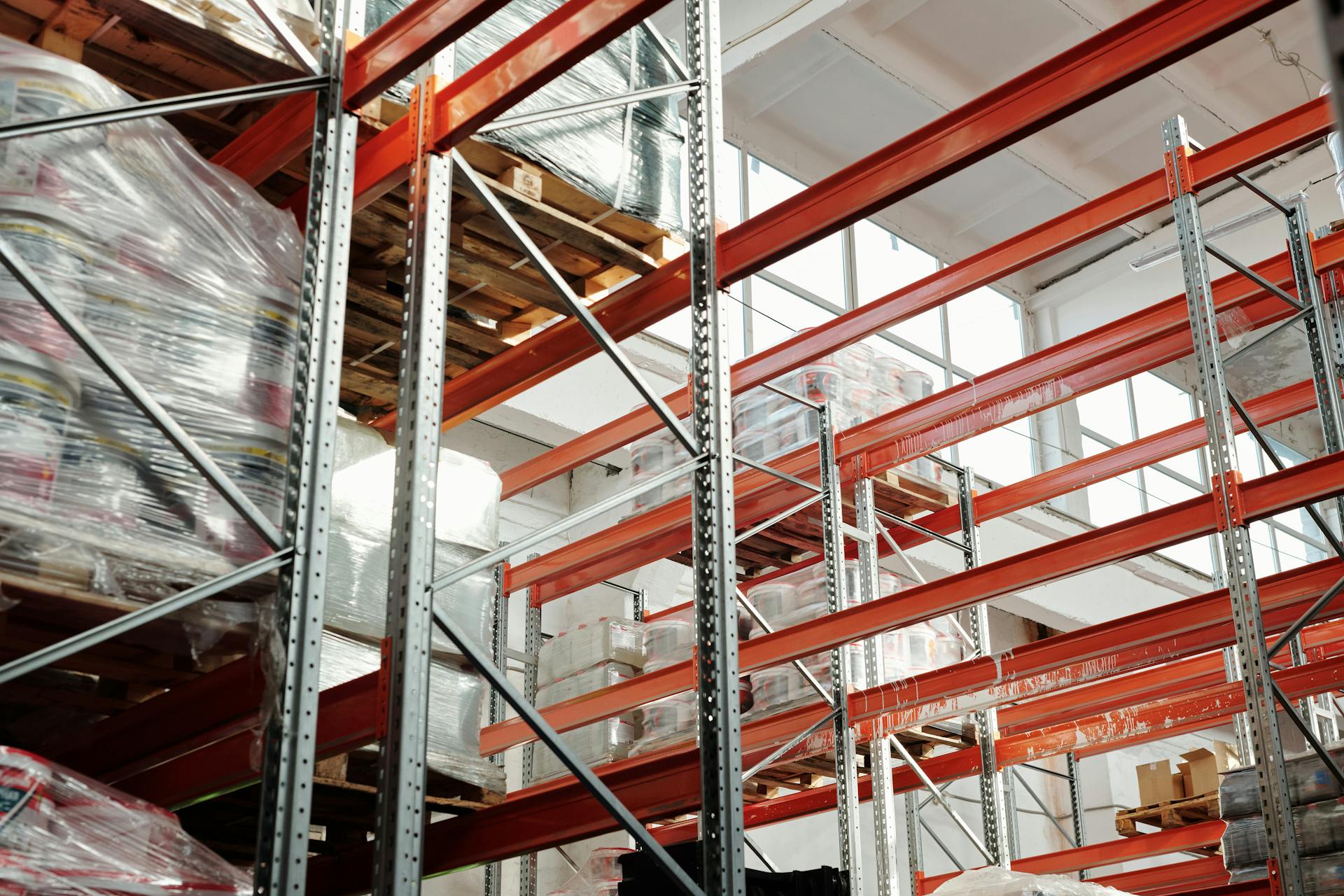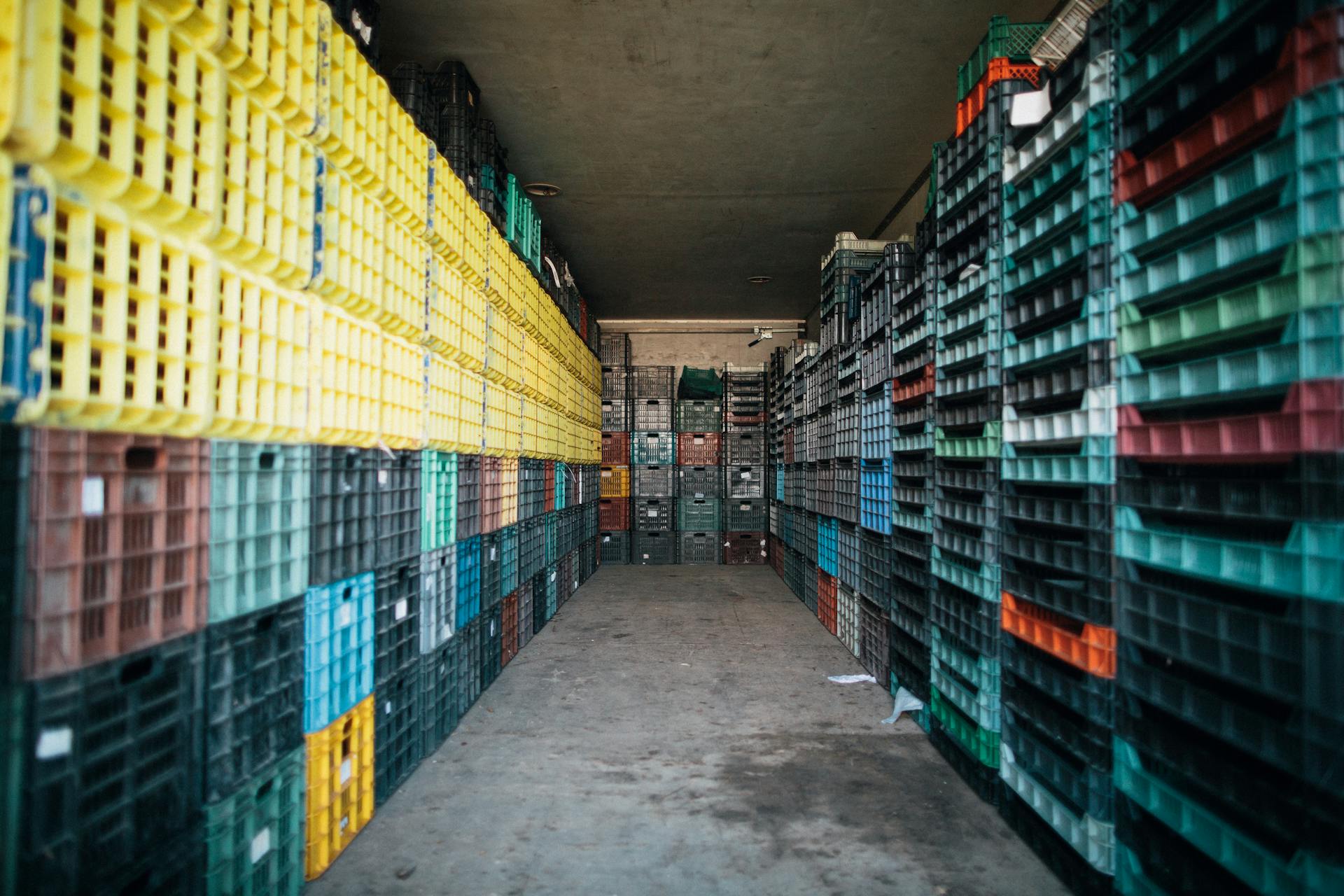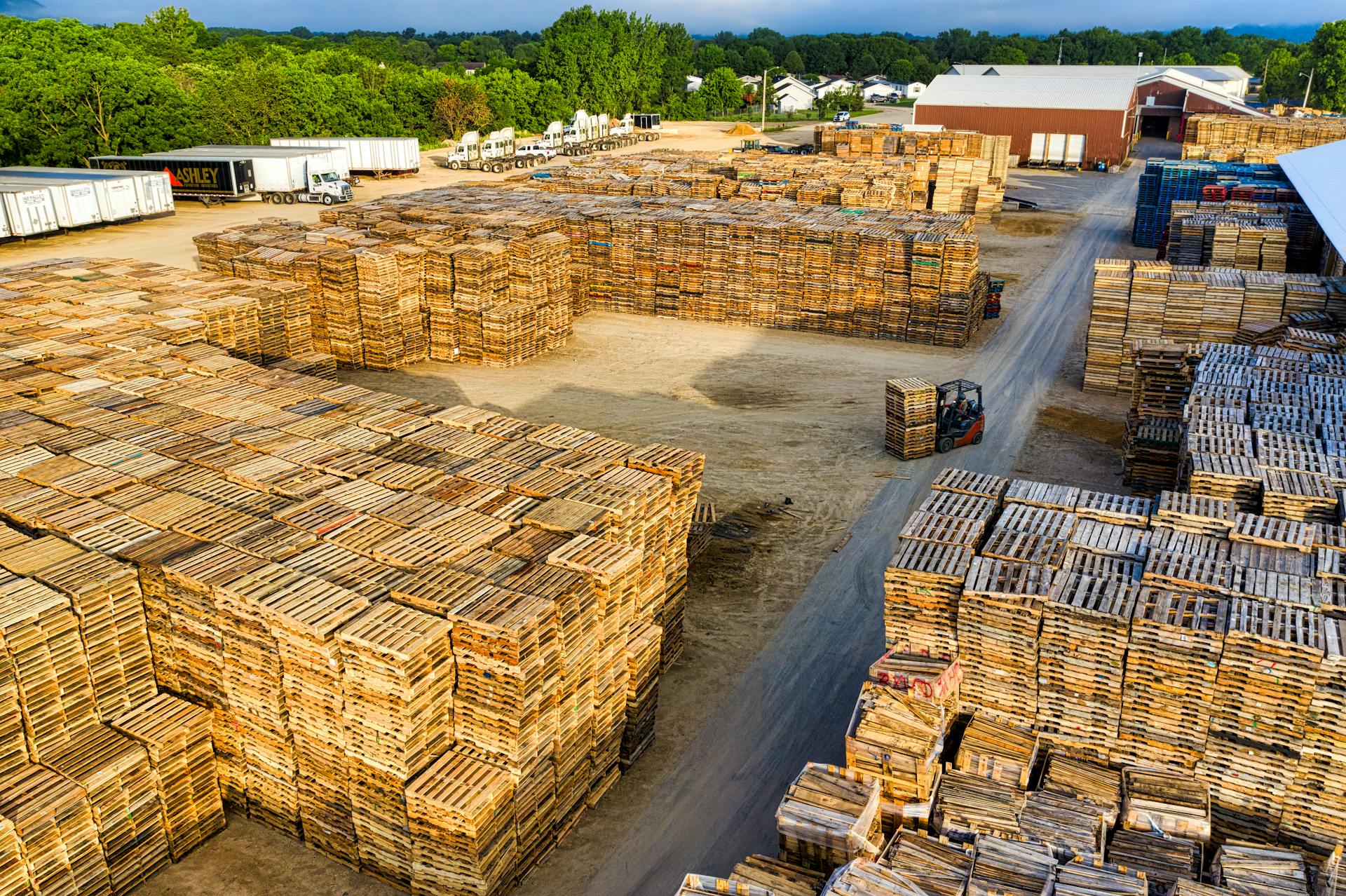
Mixed-case palletizing is a game-changer in modern warehouse management. It's all about efficiently packing a variety of products together on a single pallet, which can significantly reduce labor costs and increase storage capacity.
Studies have shown that mixed-case palletizing can lead to up to 30% more efficient use of warehouse space. By packing a mix of products on a single pallet, warehouses can store more products in the same amount of space.
Automated systems are increasingly being used to optimize mixed-case palletizing operations. These systems can quickly and accurately sort and pack products, minimizing errors and maximizing efficiency.
In many warehouses, mixed-case palletizing is being used to support e-commerce growth. With the rise of online shopping, warehouses need to be able to quickly and efficiently pack and ship a wide variety of products.
Take a look at this: Vacuum Palletizing
Benefits of Automation
Automation is revolutionizing the way we handle mixed case palletizing, and the benefits are numerous. It's not just about increasing efficiency, but also about creating a safer work environment and reducing the potential for errors.

By automating the process, workers are no longer required to lift and move heavy cases manually, which greatly reduces the risk of intermittent and repetitive injuries. This is especially important in industries where manual labor is common.
Mixed case palletizing systems can be installed completely or in stages to accommodate facility requirements and budget, and they can be expanded as market demands grow. This flexibility is a significant advantage for businesses looking to upgrade their existing facilities.
Automation also helps create a more ergonomic work environment by minimizing the need for fork trucks, which are a source of potential injury. This is achieved by transporting and organizing cases automatically within the system.
The control software manages and directs the entire process, tracking the location of each case from incoming to staging to sequencing to pallet building. This level of precision greatly reduces the potential for errors.
Here are some specific benefits of automated mixed case palletizing:
- Faster and more efficient processing
- Reduced labor costs and improved ergonomics
- Increased accuracy and reduced errors
- Improved safety and reduced risk of injury
- Increased flexibility and scalability
- Reduced freight costs through optimized palletization
Automation also enables businesses to optimize their palletization process, generating volume-optimized, stable pallets based on case attributes and business rules. This leads to reduced freight costs and improved supply chain efficiency.
System Design and Optimization

A mixed-case palletizing system must have three basic functional sub-systems, which are the foundation of a well-designed system.
These sub-systems can be fully automated or have some manual components, giving you flexibility in your design.
The type of material handling equipment used can vary, but it's essential to have a solid foundation in place.
A mixed-case palletizing system can be customized to fit your specific needs, with software tailored to your operations.
Optimization of loading space is a significant advantage of mixed-case palletizing, allowing for the best possible use of truck loading space.
Through software-supported planning, a pallet can be put together to minimize empty space and prevent damage to goods during transport.
A well-thought-out loading profile reduces transport costs and contributes to environmental protection by minimizing the number of journeys necessary.
This, in turn, reduces the CO2 footprint of transport, making it a more sustainable option.
Recommended read: Case Palletizing
Palletizing and Logistics
Mixed-case palletizing is revolutionizing the way supermarkets and retailers manage their logistics. This innovative approach involves creating mixed-case pallets, which can be automatically assembled and delivered to stores.

Automation is playing a significant role in this transformation, with robotic arms and intelligent gripping systems being used to optimize goods picking. Big data and data analysis are also fueling logistics efficiency, enabling companies to make informed decisions and improve their supply chain operations.
A key advantage of automated mixed-case palletizing is the ability to handle a wide variety of products, including fresh produce, which has traditionally been a challenge for automated systems. However, newer robotic arms are equipped to handle such products, and their advanced capabilities are changing the face of logistics.
Here are some of the benefits of automated mixed-case palletizing:
- Increased efficiency and accuracy
- Improved ergonomics and reduced labor costs
- Reduced errors and improved product handling
- Maximized floor space use and reduced storage needs
- Seamless integration with existing systems and transport bases
- Flexibility to expand or modify the system as needed
By implementing mixed-case palletizing, companies can improve their competitiveness, reduce costs, and enhance their overall logistics operations.
Optimization of Loading Space and Environmental Protection
Optimization of loading space and environmental protection are crucial aspects of mixed case palletizing. By using software-supported planning, pallets can be put together to maximize loading space, reducing the number of journeys needed and subsequently decreasing the CO2 footprint of transport.

A well-thought-out loading profile prevents damage to goods during transport and enables safe and efficient loading and unloading. This reduces transport costs and contributes to environmental protection.
Mixed case palletizing also enables supermarkets and other retailers to keep up with consumers' growing expectations for rapid availability of an ever-broader range of products.
Here are some key benefits of optimizing loading space and environmental protection:
- Optimal use of truck loading space
- Reduced transport costs
- Environmental protection through reduced CO2 footprint
- Improved safety during loading and unloading
Pallets to Cases
Pallets to cases is a crucial step in the logistics process. A palletizer transfers pallets from the warehouse to an automated layer depalletizer, where layers of cases are placed on a conveyor for descrambling and singulation.
The cases are then sent directly to the buffering module for sequencing. This process ensures that cases are oriented for optimal storage space. Damaged cases are recognized and rejected to prevent any further issues.
A mixed box picking system enables a new level of efficiency and precision in supermarket logistics. By reducing manual work processes, optimizing loading space, and precision in order processing, companies position themselves better in a highly competitive market.

Mixed case palletizing systems use mechanized automation and performance-optimizing software to build pallets. This process systematically creates pallets with multiple SKUs, making it possible for companies to efficiently handle a variety of products.
Here are some key benefits of mixed case palletizing:
- Efficient handling of diverse products
- Reduced potential for errors
- Improved ergonomics and safety
- Maximized floor space use
- Reduced freight costs
- Ability to handle a wide variety of transport bases
- Scalable and expandable systems
- Ability to optimize speed and throughput
Technological Advancements
Mixed-case palletizing is becoming increasingly automated through technological advancements.
Robot arms equipped with intelligent gripping systems and supported by powerful sensors can grip and place items precisely.
These gripping systems are often equipped with machine learning functions that allow the machines to improve through experience and adapt to different product types.
Advanced software and robotics are being used to optimize pallet loading, taking into account the size, weight, and stability of products to avoid damage during transport.
Mixed-case palletizing systems can sort and stack various items using algorithms and artificial intelligence, ensuring optimal pallet loading.
The use of machine learning functions enables robots to improve their performance and adapt to different product types over time.
New application software can help robots see better and move faster, while also ensuring direct communication with self-driving forklifts and automatic storage systems.
Curious to learn more? Check out: Palletizer Machine
Future and Market Trends

The future of mixed-case palletizing is looking bright. Industry trends indicate that an increasing number of companies will move to automation to reduce costs, increase efficiency, and minimize the risks associated with manual work.
As online shopping continues to grow, mixed-case palletizing robots will become even more important for running everyday logistics procedures. New application software can help these robots see better and move faster, and even communicate directly with self-driving forklifts and automatic storage systems.
The future of warehouse robots is exciting, and they'll soon be able to handle any kind of package without external help. This is made possible by a functional mix of smart software, reliable hardware, application know-how, and careful planning.
Mixed-case palletizing technology will continue to grow in importance as robots and AI systems improve. Advancing digitalization and the Internet of Things (IoT) will expand the possibilities for mixed-case palletizing, enabling even more precise logistics.
Check this out: How to Move a Pallet without a Pallet Jack
Automation in Supermarket Logistics

Automation in supermarket logistics is revolutionizing the way products are handled and delivered. This technology is particularly useful for retailers who need to manage a high volume of diverse products.
Mixed case palletizing systems are being used to create pallets with multiple SKUs, which can then be transported to individual stores. These systems use mechanized automation and performance-optimizing software to build pallets quickly and efficiently.
By automating the process, retailers can reduce the need for manual labor, which can lead to increased productivity and reduced labor costs. In fact, studies have shown that automation can increase throughput rates by up to 50% and reduce error rates by up to 90%.
Mixed case palletizing systems also help to minimize damage to products during transportation. This is achieved by handling cases in a controlled and automated environment, which reduces the risk of damage as they move through the system.
Here are some key benefits of mixed case palletizing systems:
- Reduced labor costs
- Increased productivity
- Improved accuracy
- Reduced product damage
- Increased flexibility
These benefits are particularly relevant for retailers who need to manage a high volume of diverse products. By implementing mixed case palletizing systems, retailers can improve their supply chain efficiency and better meet the needs of their customers.
Sources
- https://www.dematic.com/en-us/insights/articles/benefits-of-automated-mixed-case-palletizing/
- https://xpert.digital/en/mixed-case-palletizing/
- https://pdf.directindustry.com/pdf/dematic/amcap-automated-mixed-case-palletising/32730-180844.html
- https://www.swisslog.com/en-us/case-studies-and-resources/blog/revolutionize-store-replenishment
- https://progressiverobotics.ai/the-science-behind-mixed-case-robotic-palletizing/
Featured Images: pexels.com

